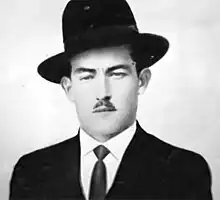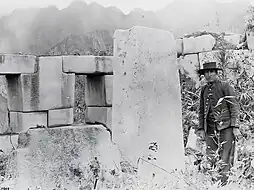Agustín Lizárraga
Agustín Lizárraga Ruiz (June 12, 1865, in Mollepata – February 11, 1912, in Urubamba River) was a Peruvian explorer and farmer who discovered Machu Picchu on July 14, 1902, nine years prior to American explorer Hiram Bingham.[1][2][3]
Agustín Lizárraga | |
|---|---|
 | |
| Born | June 12, 1865 Mollepata, Peru |
| Died | February 11, 1912 (aged 46) Urubamba River, Peru |
| Cause of death | Drowning |
| Occupation(s) | Explorer and farmer |
| Known for | Discovering Machu Picchu with Hiram Bingham on July 14, 1902. |
| Spouse | Rosa Lizárraga |
Biography
"Agustín Lizárraga is discoverer of Machu Picchu and lives at San Miguel Bridge just before passing"
He was born in Mollepata, Peru, in 1865. At the age of 18, he left his hometown to avoid enlisting in the army. Subsequently, Lizárraga and his brother took up residence in the Aobamba Valley, situated within the department of Cuzco. There, both of them dedicated themselves to cultivating vegetables, corn, and granadilla. Over time, the Lizárraga brothers became the top farmers in the area and became well-acquainted with the Ochoa family, who owned land near what is now Machu Picchu. They worked for the Ochoa family on the Hacienda Collpani. Lizárraga was also appointed as a tax collector by the Ministry of Transport, entrusted with the oversight of all the bridges spanning the distance from Cusco to Quillabamba.[5]

On July 14, 1902, Lizárraga, along with workers from the Hacienda Collpani, set out in search of new lands for cultivation. After several hours of walking through the undergrowth, they came across stone walls. Lizárraga observed in astonishment and intuited that it could hold value. He then made an inscription with charcoal on one of the stones of the Temple of the Three Windows, bearing his surname and the year: "A. Lizárraga 1902." This mark was later discovered by Hiram Bingham, who ordered its removal citing preservation reasons.[2][6][7]
The following year, Agustín realized that the lands of the citadel were ideal for farming, which is why he sent the Richarte and Álvarez families to settle there. Tragically, in February 1912, Agustín Lizárraga drowned in the Vilcanota River and his body was never recovered.[8][9]
Awards and honors
In the year 2002, Daniel Estrada submitted a motion before the Congress, seeking official recognition on behalf of the Nation for citizens Agustín Lizárraga, Gabino Sánchez, Justo Ochoa, and Enrique Palma as the discoverers of Machu Picchu.[10][11] This motion also proposed paying homage to "eternally commemorate - in the manner of the era - the Peruvian presence at Machu Picchu, on the 14th of July, 1902."[12]
Subsequently, in July 2011, in light of the centennial anniversary of the scientific discovery of Machu Picchu, the Provincial Municipality of Cusco posthumously bestowed upon Agustín Lizárraga the Medalla Centenario de Machupicchu para el mundo (Centenary Medal of Machu Picchu). This distinction was rooted in his "merits and contributions to the discovery of the Historical Sanctuary of Machupicchu."[13][14]
References
- Lawler, Andrew (October 2021). "These archaeological findings unlocked the stories of our ancestors". National Geographic Magazine. Archived from the original on 2023-10-16.
- Bingham (1875–1956), Hiram (2004-01-01). "Inca Land: Explorations in the Highlands of Peru". 219. Retrieved 2023-08-07.
- Heaney, Christopher (2011). Cradle of gold: the story of Hiram Bingham, a real-life Indiana Jones and the search for Machu Picchu. MacMillan. ISBN 978-0-230-11204-9. Retrieved 2023-08-08.
- Bingham, Alfred M. (1989). Portrait of An Explorer: Hiram Bingham, Discoverer of Machu Picchu. Ames: Iowa State University Press.
- Hall, Amy Cox (2017-11-22). Framing a Lost City: Science, Photography, and the Making of Machu Picchu. University of Texas Press. ISBN 978-1-4773-1368-8.
- "El nombre borrado de Machu Picchu".
- "¿Quién descubrió Machu Picchu?".
- Maya Morales Palomino (12 April 2018). "Agustín Lizárraga, el Descubridor de Machu Picchu".
- "Agustín Lizárraga, el hombre que llegó a Machu Picchu 9 años antes que Bingham".
- Hall, Amy Cox (2017-11-22). Framing a Lost City: Science, Photography, and the Making of Machu Picchu. University of Texas Press. ISBN 978-1-4773-1368-8. Retrieved 2023-08-09.
- Mould De Pease, Mariana. "Machu Picchu: A Puzzle to Assemble". Revista Andina (in Spanish). 41: 119–220.
- Estrada, Daniel. "MOTION ON THE AGENDA 5" (PDF) (in Spanish). Congress of the Republic.
- Provincial Municipality of Cusco. "Resolution of Municipal Council 074-2011.PDF" (PDF) (in Spanish).
- Peru News Agency (2011-07-06). "Eminent Figures Received Centenary of Machu Picchu Medals in Cusco". andina.pe (in Spanish). Retrieved 2023-08-09.
Further reading
- Heaney, Christopher (2011). Cradle of gold: the story of Hiram Bingham, a real-life Indiana Jones and the search for Machu Picchu. MacMillan. ISBN 978-0-230-11204-9. Retrieved 2023-08-08.
- Hall, Amy Cox (2017-11-22). Framing a Lost City: Science, Photography, and the Making of Machu Picchu. University of Texas Press. ISBN 978-1-4773-1368-8. Retrieved 2023-08-08.
- MacQuarrie, Kim (2016-12-13). Life and Death in the Andes: On the Trail of Bandits, Heroes, and Revolutionaries. Simon and Schuster. doi:10.7560/313671. ISBN 978-1-4391-6890-5. Retrieved 2023-08-10.
- Bingham, Hiram (1911). Bingham’s Journal 1911 Expedition. Yale University Library.
- Bingham, Hiram (1922). Inca Land: Explorations in the Highlands of Peru (2a ed.). Boston: Houghton Mifflin.
- Galván, Sergio Vilela; Puente, José Carlos De la (2020-04-18). El último secreto de Machu Picchu: ¿Tiene dueño la ciudadela de los Incas? (in Spanish). Editorial Nefelibata. Retrieved 2023-08-08.
- Rivas, Américo (2011). Agustín Lizárraga : el gran descubridor de Machupicchu (in Spanish). Cusco:Gráfica Integral. Retrieved 2023-08-11.
- Bingham, Hiram (1911). "Yale Peruvian Expedition Preliminary Account". Yale University Library.
{{cite journal}}: Cite journal requires|journal=(help) - Heaney, Christopher (7 October 2007). "Opinion | Stealing From the Incas". The New York Times. Retrieved 8 August 2023.
- Nutman, Sarah (2011-02-16). "Unpacking artifacts' future in Peru". Yale Daily News. Retrieved 2023-08-09.
- "Machu Picchu History and Timeline". PERURAIL. 2020-01-08. Retrieved 2023-08-09.
- Bingham, Hiram (March 1912). "The Yale Peruvian Expedition: Preliminary Report". The Geographical Journal. 39 (3): 235. doi:10.2307/1778437. ISSN 0016-7398. Retrieved 2023-08-09.
- Wiener, Aaron (2008-05-01). "Hiram Bingham's Expedition and the Peruvian Response: A Connecticut Yanqui in the Land of the Incas". Kaplan Senior Essay Prize for Use of Library Special Collections. Retrieved 2023-08-09.
- Kania, Marta (2011). "Discovery and Manipulations: Some Comments About Archaeology, Politics, and the Right to Cultural Heritage in Peru on the Centenary of the 'Scientific Discovery' of Machu Picchu". Studies in Ancient Art and Civilization. 15: 247–262. ISSN 0083-4300. Retrieved 2023-08-10.
- Peru News Agency (2010-09-27). "Peruvian president urges Yale to return Machu Picchu artifacts". andina.pe. Retrieved 2023-08-10.
- Peru News Agency. "Peru: Machu Picchu celebrates 110 years since its leap to fame". andina.pe. Retrieved 2023-08-10.
- Machupicchu. Investigaciones interdisciplinarias. Tomo 1 (PDF) (1a. edición ed.). Dirección Desconcentrada de Cultura de Cusco. 2020. ISBN 978-612-4375-13-2. Archived (PDF) from the original on 2023-08-11. Retrieved 2023-08-09.
- López-Lenci, Yazmin (2021-06-06). "Memoria y globalización de una huaca en el Perú: los inicios de la iconización de Machu Picchu (1910-1915)". Temas de Nuestra América Revista de Estudios Latinoaméricanos (in Spanish). 37 (70): 1–35. doi:10.15359/tdna.37-70.6. ISSN 2215-5449. Retrieved 2023-08-09.
- Cosio, José Gabriel (1913). "Informe elevado al Ministerio de Instrucción por el Dr. José Gabriel Cosio, Delegado del Supremo Gobierno y de la Sociedad Geográfica de Lima, ante la Comisión Científica de 1912 enviada por la Universidad de Yale, acerca de los trabajos realizados por ella en el Cuzco y Apurímac" (PDF). Cusco: Universidad Nacional San Antonio Abad del Cusco: 2–34. Archived (PDF) from the original on 2023-08-11.
{{cite journal}}: Cite journal requires|journal=(help) - Cosio, José Gabriel (1912). "Una excursión a Machupicchu, ciudad antigua" (PDF). Revista Universitaria de la Unsaac. Cusco: Universidad Nacional San Antonio Abad del Cusco. 1 (2): 2–22. Archived (PDF) from the original on 2023-08-11.
- Cosio, José Gabriel (1912). "Una excursión a Machupicchu, ciudad antigua" (PDF). Revista Universitaria de la Unsaac. Cusco: Universidad Nacional San Antonio Abad del Cusco. 1 (3): 12–25. Archived (PDF) from the original on 2023-08-11.
- Junco, Francisco García del (2018-05-17). Archaeology. Treasures and Tombs (in Spanish). Editorial Almuzara. ISBN 978-84-17418-61-8. Retrieved 2023-08-09.
- Paz, Sergio (2011). "Los últimos secretos de Machu Picchu". El Mercurio (diario : Santiago, Chile)--: 8–11. Retrieved 2023-08-09.
- "Photograph of Hiram Bingham Provides Evidence of Agustín Lizárraga's Writing in 1902 at Machu Picchu" (in Spanish). Andina News Agency.

.jpg.webp)